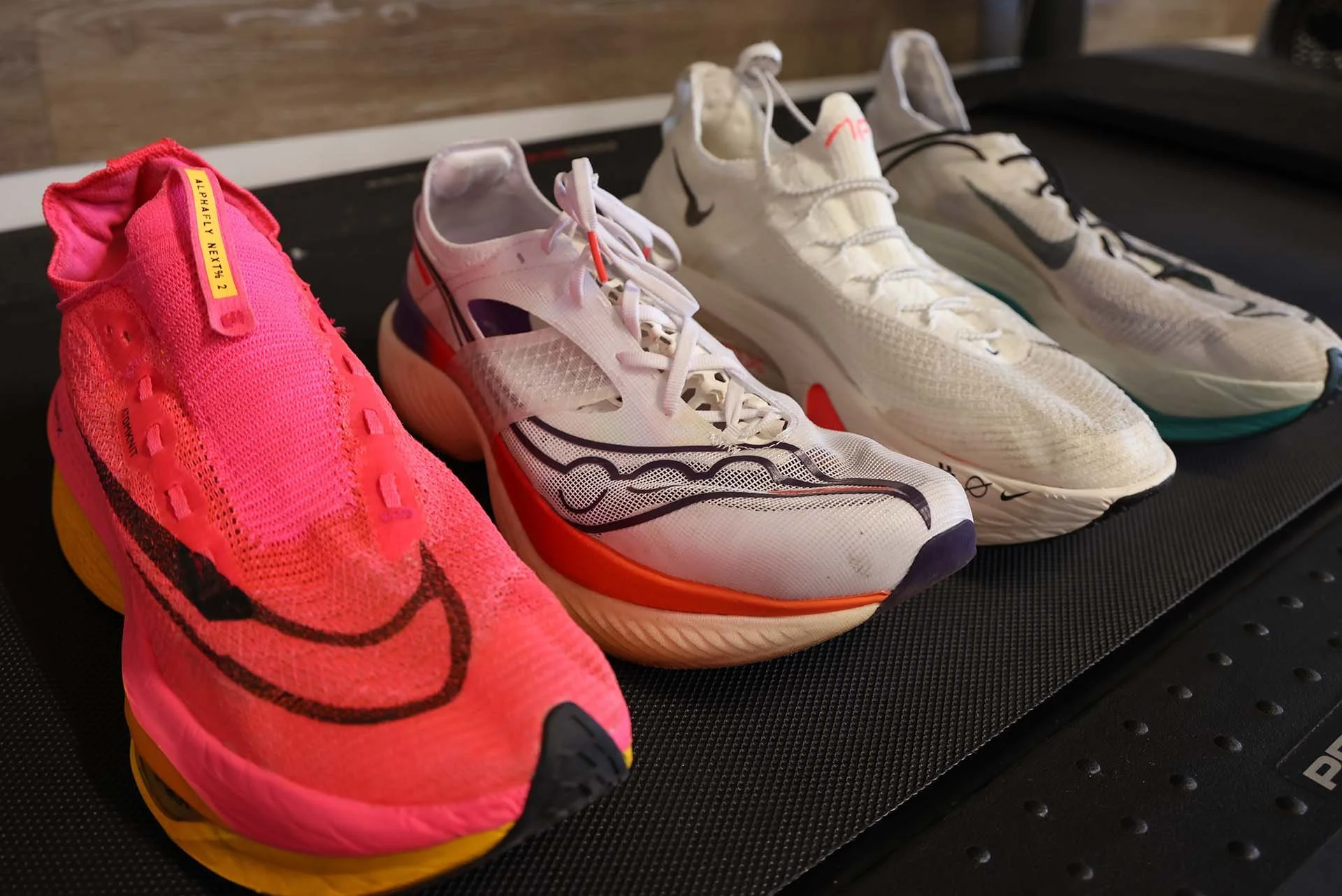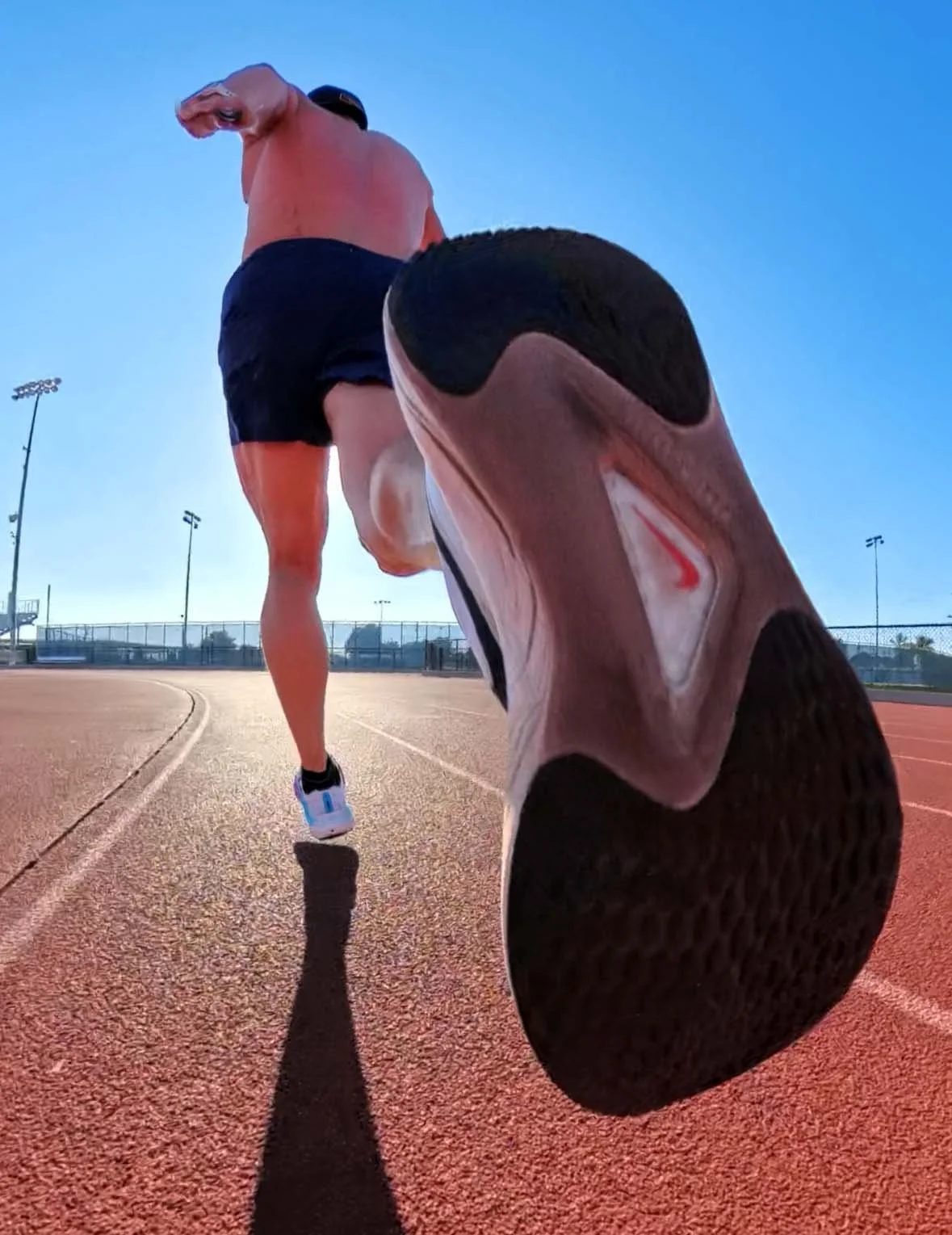Carbon-Plated Running Shoes Are Faster, But Why?
Carbon-plated running shoes are all the rage thanks to their promise of faster times and more efficient energy use. By incorporating carbon plates into the midsole, these shoes provide increased propulsion and a more efficient stride. Recently, while buying a pair of Nike Alphafly 3’s and a recent discussion on The Triathlon Show podcast, I started reading too much about them. I wanted to understand their benefits and when they kick in. So here is what I learned.
If you aren’t interested in the details, I’ll tell you the facts I most wanted to know first. Do these shoes really help at the speeds I’m running? I learned that carbon-plated running shoes generally start to provide noticeable benefits around speeds of 7:30 per mile (4:40 per km) or faster. At these speeds, the biomechanics of running—such as force and cadence—activate the carbon plate more effectively, allowing the shoe to create a spring-like effect that helps propel the runner forward with each stride. With that said, if you are running at slower paces, you may still experience comfort benefits, but the efficiency gains will be less pronounced. So now, if you want to know more about these “super shoes,” keep reading!
The Key Components of Carbon-Plated Running Shoes
Carbon Plate - The main feature of these shoes is the thin, stiff carbon plate embedded within the midsole. The plate is typically positioned between layers of responsive foam and extends from the heel to the toe. The plate helps propel the foot forward by acting like a spring, creating a rocker effect that reduces the energy each stride requires.
Responsive Foam - Carbon-plated shoes also use advanced, lightweight foams in the midsole. These "superfoams," provide high energy return, meaning they absorb impact and return energy with each step. Combining the foam with the carbon plate further amplifies the energy return, creating a more powerful toe-off.
Rocker Geometry - You may have noticed that most carbon-plated shoes have a noticeable curved or "rocker" shape that rolls the foot forward, allowing a smooth transition from heel to toe. This helps minimize the ground contact time and achieve a more efficient stride, propelling the runner forward with less effort.
How Carbon-Plated Running Shoes Enhance Speed
Increased Energy Return and Propulsion
The carbon plate provides a stiff base that helps direct force forward, acting as a spring to push the runner off the ground with each step. Combined with the super foam, that plate allows a runner to conserve energy, requiring less effort to move forward. Studies have shown that carbon-plated shoes can improve running economy (the amount of oxygen used at a given pace) by around 4%. This is a substantial increase in endurance and speed over longer distances.
Reduced Muscle Fatigue
Running long distances causes muscle fatigue due to repetitive impact and the energy needed to maintain each stride. Carbon-plated shoes reduce this fatigue by absorbing more shock and returning more energy to the runner. Less muscle fatigue means runners can sustain higher speeds longer and experience less wear and tear on their muscles, especially in the calves and quads.
More Efficient Stride Mechanics
The stiffness of the carbon plate, combined with the shoe's rocker, helps optimize the mechanics of each stride. By rolling the foot forward, runners move more fluidly and with less resistance. This reduces the energy lost in wasted movements, such as long ground contact time and vertical oscillation.
Improved Stability and Alignment
A carbon-plated shoe provides a very stable foot structure, which is particularly beneficial for runners who might have issues with pronation or supination. Promoting a more neutral alignment, these shoes help prevent lateral foot movement, keeping energy directed forward rather than to the side.
Why Carbon-Plated Shoes Are Especially Effective for Long-Distance Racing
Enhanced Efficiency Over Longer Distances
The benefits of carbon-plated shoes are most evident over long distances, where energy savings add up with each stride. Even small reductions in energy use can translate to substantial time savings in marathon and half-marathon races. Many elite marathoners have improved splits and reduced late-race fatigue with carbon-plated shoes, helping them maintain a strong pace through the latter parts of the race.
Recovery Benefits
These shoes improve performance and reduce recovery time after intense races or training sessions. Their energy-returning properties reduce the impact on muscles and joints, meaning runners can return to training sooner. Many runners feel fresher in the days following a race or hard workout when using carbon-plated shoes, which is particularly valuable for training cycles that involve frequent long runs or high mileage.
Competitive Edge
Carbon-plated shoes have become a common choice among competitive runners. They offer measurable advantages over traditional running shoes, and athletes in competitive fields benefit from wearing shoes that maximize their speed potential. Carbon-plated shoes offer a tangible edge in marathon races, where seconds can make a difference in rankings or achieving a personal best.
Are Carbon-Plated Shoes Right for Everyone?
While carbon-plated shoes offer substantial benefits, they may not be the best fit for every runner. Here are some considerations:
High Speeds and Forefoot Striking
The benefits of carbon-plated shoes are most apparent for runners who maintain a faster pace and use a midfoot or forefoot strike. This allows them to take full advantage of the plate's propulsion effect. Slower runners or heel-strikers may not experience the same benefits and could find the stiff structure less comfortable for regular training runs.
Price Point
Due to their advanced materials and technology, carbon-plated shoes are often more expensive than traditional running shoes. While they can make a significant difference in races, some runners might opt for a lower-cost shoe for daily training.
Durability for Training vs. Racing
Carbon-plated shoes are designed for racing, which can affect durability. They may wear out faster when used in everyday training, so some runners reserve them for races or specific workouts to maximize their lifespan.
Adaptation Period
Runners new to carbon-plated shoes may need an adjustment period, as the stiffness and rocker profile can feel different compared to traditional shoes. Incorporating them gradually into training can help the body adjust to the altered mechanics.
Faster Times Through Innovation
Carbon-plated running shoes are a significant innovation in running shoe technology, helping runners move faster and with less energy. By improving energy return, enhancing stride mechanics, and reducing muscle fatigue, these shoes are a powerful tool for maximizing performance, especially over long distances. However, you need to decide whether there are enough benefits at the speeds you are running, the short lifetime of the shoes, and the $200-$350 price you will pay. For me, the answer has been yes!



